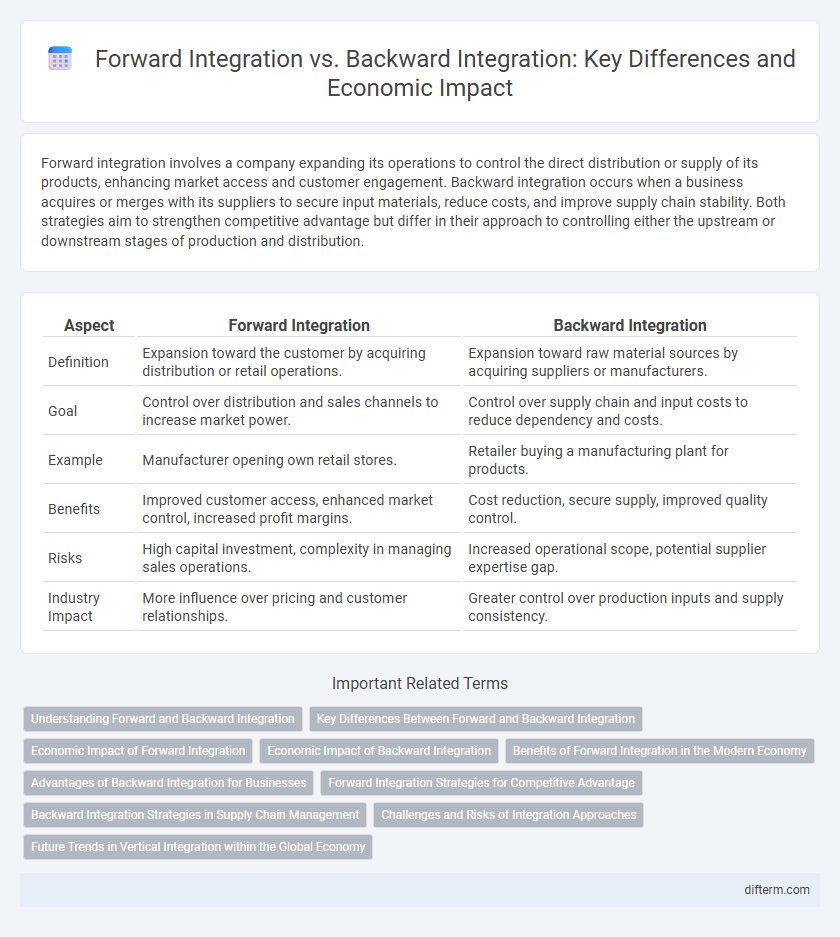Forward integration involves a company expanding its operations to control the direct distribution or supply of its products, enhancing market access and customer engagement. Backward integration occurs when a business acquires or merges with its suppliers to secure input materials, reduce costs, and improve supply chain stability. Both strategies aim to strengthen competitive advantage but differ in their approach to controlling either the upstream or downstream stages of production and distribution.
Table of Comparison
| Aspect | Forward Integration | Backward Integration |
|---|---|---|
| Definition | Expansion toward the customer by acquiring distribution or retail operations. | Expansion toward raw material sources by acquiring suppliers or manufacturers. |
| Goal | Control over distribution and sales channels to increase market power. | Control over supply chain and input costs to reduce dependency and costs. |
| Example | Manufacturer opening own retail stores. | Retailer buying a manufacturing plant for products. |
| Benefits | Improved customer access, enhanced market control, increased profit margins. | Cost reduction, secure supply, improved quality control. |
| Risks | High capital investment, complexity in managing sales operations. | Increased operational scope, potential supplier expertise gap. |
| Industry Impact | More influence over pricing and customer relationships. | Greater control over production inputs and supply consistency. |
Understanding Forward and Backward Integration
Forward integration involves a company expanding its operations towards the end consumer by acquiring or establishing control over distribution channels and retail outlets. Backward integration occurs when a firm takes ownership of its supply sources, such as raw material suppliers or manufacturing inputs, to reduce dependency and increase control over production. Both strategies aim to enhance competitive advantage, improve supply chain efficiency, and increase market power within an industry.
Key Differences Between Forward and Backward Integration
Forward integration involves a company expanding its control over distribution channels or retail outlets, allowing direct access to customers and greater market influence. Backward integration occurs when a company acquires or merges with suppliers to control raw materials and reduce input costs. The key differences lie in their focus areas: forward integration targets downstream processes to enhance customer reach, while backward integration targets upstream supply chains to improve production efficiency.
Economic Impact of Forward Integration
Forward integration enhances a company's market control by expanding its presence closer to the end consumer, increasing profit margins through direct sales channels. This strategic move often leads to improved supply chain efficiency, cost reduction, and stronger brand recognition by eliminating intermediaries. Economically, forward integration can drive higher revenue growth and market share, stimulating competitive advantage within the industry.
Economic Impact of Backward Integration
Backward integration reduces dependency on suppliers by enabling firms to control raw material sources, leading to cost savings and improved profit margins. It enhances supply chain stability and mitigates risks associated with price volatility and supply disruptions. This strategic move often results in increased market power and long-term competitive advantage within the industry.
Benefits of Forward Integration in the Modern Economy
Forward integration enhances control over distribution channels, leading to improved market access and increased profit margins in the modern economy. Companies gain direct interaction with customers, enabling better brand loyalty and tailored marketing strategies. Streamlined operations reduce dependency on intermediaries, resulting in faster response times to market trends and consumer demands.
Advantages of Backward Integration for Businesses
Backward integration enhances control over supply chains, reducing dependency on suppliers and lowering production costs. It improves quality control by managing raw materials and components directly, leading to consistent product standards. Furthermore, backward integration secures timely access to critical inputs, minimizing risks related to supply disruptions and price volatility.
Forward Integration Strategies for Competitive Advantage
Forward integration strategies enhance competitive advantage by enabling companies to control distribution channels, improve market access, and increase profit margins. Businesses adopting forward integration often achieve greater customer intimacy, streamline supply chains, and reduce dependency on intermediaries. This approach supports stronger brand presence and accelerates product delivery, contributing to sustained market dominance.
Backward Integration Strategies in Supply Chain Management
Backward integration strategies in supply chain management involve a company acquiring or merging with its suppliers to gain greater control over raw materials and production processes. This approach enhances supply chain efficiency, reduces dependency on external suppliers, and lowers costs by streamlining procurement and minimizing supply disruptions. Companies implementing backward integration can improve product quality and increase bargaining power in the market by directly managing upstream operations.
Challenges and Risks of Integration Approaches
Forward integration faces challenges such as increased capital expenditure and complexity in managing distribution channels, which may strain organizational resources. Backward integration risks include supply chain inflexibility and potential supplier conflicts, leading to disruptions in production. Both approaches carry operational risks like reduced focus on core competencies and the need for significant expertise in new business areas.
Future Trends in Vertical Integration within the Global Economy
Future trends in vertical integration within the global economy indicate a growing emphasis on forward integration as companies seek to control distribution channels and enhance customer experience through direct-to-consumer models. Technological advancements such as AI-driven supply chain analytics and blockchain are facilitating more efficient backward integration by enabling transparency and streamlined procurement of raw materials. Businesses leveraging hybrid strategies that combine forward and backward integration are positioning themselves to adapt swiftly to market disruptions and achieve sustainable competitive advantages.
Forward Integration vs Backward Integration Infographic

 difterm.com
difterm.com